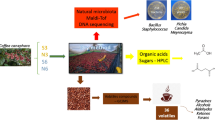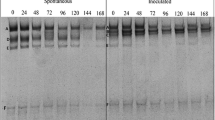Abstract
This work evaluated the bacterial diversity during coffee wet fermentation of the three coffee varieties—Mundo Novo (MN), Ouro Amarelo (OA), and Catuaí Vermelho (CV). Isolates were identified by polyphasic techniques: biochemical tests, matrix-assisted laser desorption/ionization-time of flight (MALDI-TOF) and DNA sequencing. Chemical compositions were determined by high (HPLC) and gas chromatography-mass spectrometry (GC-MS) and the roasted beans were sensorial evaluated using the cupping test. Thirty-six mesophilic bacteria and six lactic acid bacteria were identified. Lactobacillus plantarum and Leuconostoc mesenteroides were often found in all varieties. Citric acid was the acid detected in higher concentrations. The volatile profile of the green coffee beans changed during the fermentation in the tank, but more significantly, during the roasting process. These volatiles belonged to the classes of acids, alcohols, aldehydes, and hydrocarbons. Temporal dominance of sensations analysis showed sensorial sensations of acidity (OA and CV), bitterness, chocolate, nuts (MN), and sweetness (CV). The characteristics of each coffee variety were distinct, mainly in relation to total bacteria population, volatile compounds, and sensorial profile. In conclusion polyphasic methodology was efficiently done for bacteria identification; the dominant bacteria might be used for starter cultures and the chemical and sensory analyses helped to understand the changes in coffee fermentation. Our findings are relevant to future select starter bacteria for coffee processing to improve quality and standardization of quality.



Similar content being viewed by others
References
Agate AD, Bhat JV (1966) Role of pectinolytic yeasts in the degradation of mucilage layer of Coffea robusta cherries. Appl Microbiol 14:256–260
Association of Official Analytical Chemists (AOAC) (1995) Official methods of analyses of the Association of Official Analytical Chemists, 15th edn. Arlington, Texas
Avallone S, Guyot B, Brillouet J-M, Olguin E, Guiraud JP (2001) Microbiological and biochemical study of coffee fermentation. Curr Microbiol 42:252–256
Avallone S, Brillouet JM, Guyot B, Olguin E, Guiraud JP (2002) Involvement of pectolytic micro-organism in coffee fermentation. Int J Food Sci Technol 37:191–198
Bitter T, Muir HM (1962) A modified uronic acid carbazole reaction. Anal Biochem 34:330–334
Brando CHJ, Brando MF (2015) Methods of coffee fermentation and drying. In: Schwan RF, Fleet GH (eds) Cocoa and coffee fermentation. CRC Taylor & Francis, Boca Raton, pp 367–398
Carvalho BF, Ávila CLS, Bernardes TF, Pereira MN, Santos C, Schwan RF (2016) Fermentation profile and identification of lactic acid bacteria and yeasts of rehydrated corn kernel silage. J Appl Microbiol 122:589–600
Cheng B, Furtado A, Smyth HE, Henry R (2016) Influence of genotype and environment on coffee quality. Trends Food Sci Technol 57:20–30
Companhia Nacional de Abastecimento (Conab) (2018) Acompanhamento da safra brasileira de café, v. 5 – Safra 2018, n.1 – Primeiro Levantamento, Brasília, p. 1–72. http://www.conab.gov.br. Accessed 22 Feb 2018
Devereux R, Willis SG (1995) Amplification of ribosomal RNA sequences. In: Akkermans ADL, Van Elsas JD, Bruijn FJ (eds) Molecular microbiology ecology manual. Kluwer Academic Publishers, Netherlands, pp 1–11
Doan NTL, Van Hoorde K, Cnockaert M, De Brandt E, Aerts M, Le Thanh B, Vandamme P (2012) Validation of MALDI-TOF MS for rapid classification and identification of lactic acid bacteria, with a focus on isolates from traditional fermented foods in Northern Vietnam. Lett Appl Microbiol 55:265–273
Evangelista SR, Miguel MGCP, Cordeiro CS, Silva CF, Pinheiro ACM, Schwan RF (2014a) Inoculation of starter cultures in a semi-dry coffee (Coffea arabica) fermentation process. Food Microbiol 44:87–95
Evangelista SR, Silva CF, Miguel MGPC, Cordeiro CS, Pinheiro ACM, Duarte WF, Schwan RF (2014b) Improvement of coffee beverage quality by using selected yeasts strains during the fermentation in dry process. Food Res Int 61:183–195
Evangelista SR, Miguel MGCP, Silva CF, Pinheiro ACM, Schwan RF (2015) Microbiological diversity associated with the spontaneous wet method of coffee fermentation. Int J Food Microbiol 210:102–112
EzTaxon (2017) http://www.ezbiocloud.net/eztaxon. Accessed 15 Apr 2017
Ferreira DF (2014) Sisvar: a guide for its bootstrap procedures in multiple comparisons. Ciên Agrotecnol 38:109–112
Frank HA, Cruz ASD (1964) Role of incidental microflora in natural decomposition of mucilage layer in Kona coffee cherries. J Food Sci 29:850–853
Frank HA, Lum NA, Cruz ASD (1965) Bacteria responsible for mucilage-layer decomposition in Kona coffee cherries. Appl Microbiol 13:201–207
Hamdouche Y, Meile JC, Nganou DN, Durand N, Teyssier C, Montet D (2016) Discrimination of post-harvest coffee processing methods by microbial ecology analyses. Food Control 65:112–120
Holt JG, Krieg NR, Sneath PHA, Staley JT, Williams ST (1994) Bergey’s manual of determinative bacteriology, 9th edn. W. & Wilkins, Baltimore
International Coffee Organization (ICO) (2015) http://consorciopesquisacafe.com.br/arquivos/consorcio/publicacoes_tecnicas/Relatorio-OIC-marco-2015.pdf. Accessed 16 Mar 2015
Kim OS, Cho YJ, Lee K, Yoon SH, Kim M, Na H, Park SC, Jeon YS, Lee JH, Yi H, Won S, Chun J (2012) Introducing EzTaxon: a prokaryotic 16S rRNA gene sequence database with phylotypes that represent uncultured species. Int J Syst Evol Microbiol 62:716–721
Lee LW, Cheong MW, Curran P, Yu B, Liu SQ (2015) Coffee fermentation and flavor – an intricate and delicate relationship. Food Chem 185:182–191
Lingle TR (2011) The coffee cupper’s handbook: Systematic guide to the sensory evaluation of coffee’s flavor. (4th edn). In: Long Beach: Specialty Coffee Association of America, 66 p
McCready RM, McComb EA (1952) Extraction and determination of total pectic materials. Anal Chem 24:1586–1588
Nguyen DTL, Van Hoorde K, Cnockaert M, De Brandt E, Aerts M, Thanh Le Binh T, Vandamme P (2013) A description of the lactic acid bacteria microbiota associated with the production of traditional fermented vegetables in Vietnam. Int J Food Microbiol 163:19–27
Nunes CA, Pinheiro ACM (2012) Sensomarker free user-friendly interface for sensory analysis www.ufla.br/sensomaker. Accessed 25 Jan 2017
Papagianni M, Mattey M, Berovic M, Kristiansen B (1999) Aspergillus niger morphology and citric acid production in submerged batch fermentation: effects of culture pH, phosphate and manganese levels. Food Technol Biotechnol 37:165–171
Pavlovic M, Konrad R, Iwobi AN, Sing A, Busch U, Huber I (2012) A dual approach employing MALDI-TOF MS and real-time PCR for fast species identification within the Enterobacter cloacae complex. FEMS Microbiol Lett 328:46–53
Pineau N, Schlich P, Cordelle S, Mathonnière C, Issachou S, Imbert A, Rogeaux M, Etièvant P, Köster E (2009) Temporal dominance of sensations: construction of the TDS curves and comparison with time–intensity. Food Qual Prefer 20:450–455
Quintero GIP, Molina JGE (2015) Fermentación controlada del café: Tecnología para agregar valor alacalidad. Avances Técnicos/Cenicafé 454:12p
Ribeiro LS, Miguel MGCP, Evangelista SR, Martins PMM, van Mullem J, Belizario MH, Schwan RF (2017a) Behavior of yeast inoculated during semi-dry coffee fermentation and the effect on chemical and sensorial properties of the final beverage. Food Res Int 92:26–32
Ribeiro LS, Ribeiro DE, Evangelista SR, Miguel MGCP, Pinheiro ACM, Borém FM, Schwan RF (2017b) Controlled fermentation of semi-dry coffee (Coffea arabica) using starter cultures: a sensory perspective. LWT Food Sci Technol 82:32–38
Sakiyama CCH, Paula EM, Pereira PC, Borges AC, Silva DO (2001) Characterization of pectin lyase produced by an endophytic strain isolated from coffee cherries. Lett Appl Microbiol 33:117–121
Santos C, Ventura JA, Costa H, Fernandes PMB, Lima N (2015) MALDI-TOF MS as an analytical technique for multistep identification of pathogenic and antagonist fungi on rotten pineapple. Trop Plant Pathol 40:227–232
Schwenninger SM, Leischtfeld SF, Gantenbein-Demarchi G (2016) High-throughput identification of the microbial biodiversity of cocoa bean fermentation by MALDI-TOF MS. Lett Appl Microbiol 63:347–355
Senguna IY, Nielsen DS, Karapinar M, Jakobsen M (2009) Identification of lactic acid bacteria isolated from Tarhana, a traditional Turkish fermented food. Int J Food Microbiol 135:105–111
Silva CF (2015) Microbial activity during coffee fermentation. In: Schwan RF, Fleet GH (eds) Cocoa and coffee fermentation. CRC Taylor & Francis, Boca Raton, pp 398–423
Silva CF, Batista LR, Abreu LM, Dias ES, Schwan RF (2008) Succession of bacterial and fungal communities during natural coffee (Coffea arabica) fermentation. Food Microbiol 25:951–957
Soccol CR, Vandenberghe LPS, Rodrigues C, Pandey A (2006) New perspectives for citric acid production and application. Food Technol Biotechnol 44:141–149
Vaughan MJ, Mitchell T, Gardener BBM (2015) What’s inside that seed we brew? A new approach to mining the coffee microbiome. Appl Environ Microbiol 81:6518–6527
Velmourougane K (2012) Impact of natural fermentation on physicochemical, microbiological and cup quality characteristics of arabica and robusta coffee. Proc Natl Acad Sci India Sect B Biol Sci 83:233–239
Viana RO, Magalhães-Guedes KT, Jr Braga RA, Dias DR, Schwan RF (2017) Fermentation process for production of apple-based kefir vinegar: microbiological, chemical and sensory analysis. Braz J Microbiol 48:592–601
Von Wright A, Axelsson L (2012) Lactic acid bacteria: an introduction. In: Lahtinen S, Ouwehand AC, Salminen S, Von Wright A (eds) Lactic acid bacteria, microbiological and functional aspects. CRC: Taylor & Francis, Boca Raton, pp 1–16
Wendler R, Veith R, Dancer J, Stitt M, Komor L (1990) Sucrose storage in cell suspension cultures of Saccharum sp. (sugarcane) is regulated by a cycle of synthesis and degradation. Planta 183:31–39
Acknowledgments
We thank Daterra farm, Patrocínio, Minas Gerais, Brazil, for collecting the samples.
Funding
This study received financial support from the Brazilian agencies, Conselho Nacional de Desenvolvimento Científico e Tecnológico do Brasil (CNPQ), Fundação de Amparo à Pesquisa do Estado de Minas Gerais (FAPEMIG), and Coordenação de Aperfeiçoamento de Pessoal de Nível Superior (CAPES).
Author information
Authors and Affiliations
Corresponding author
Ethics declarations
Conflict of interest
The authors declare that they have no conflict of interest.
Electronic supplementary material
ESM 1
(DOCX 40 kb)
Rights and permissions
About this article
Cite this article
Ribeiro, L.S., Evangelista, S.R., da Cruz Pedrozo Miguel, M.G. et al. Microbiological and chemical-sensory characteristics of three coffee varieties processed by wet fermentation. Ann Microbiol 68, 705–716 (2018). https://doi.org/10.1007/s13213-018-1377-4
Received:
Accepted:
Published:
Issue Date:
DOI: https://doi.org/10.1007/s13213-018-1377-4




